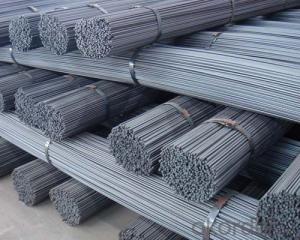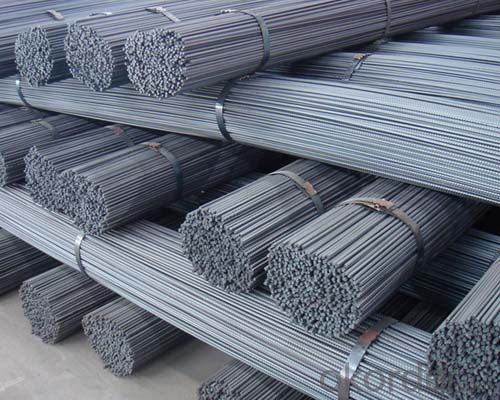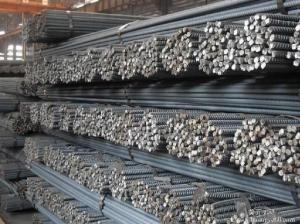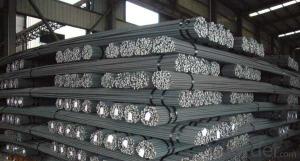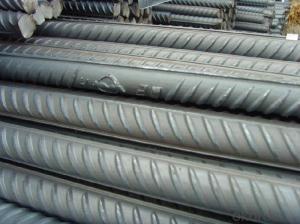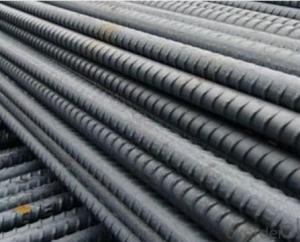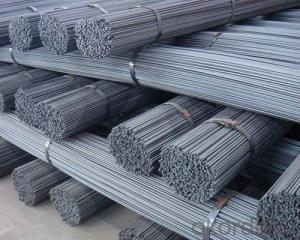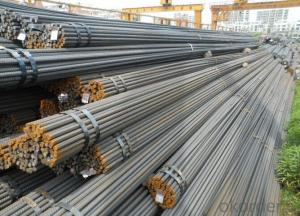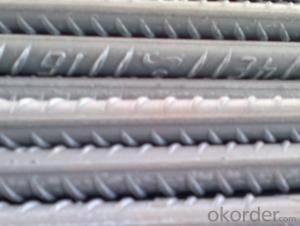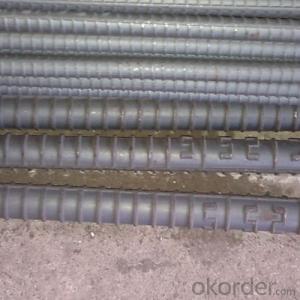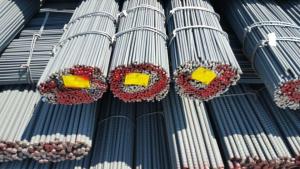Reinforcing Deformed Steel Bars with Grade HRB400-HRB500
- Loading Port:
- Tianjin
- Payment Terms:
- TT OR LC
- Min Order Qty:
- 25 m.t.
- Supply Capability:
- 20000 m.t./month
OKorder Service Pledge
OKorder Financial Service
You Might Also Like
Specification
OKorder is offering high quality Hot Rolled Rebars at great prices with worldwide shipping. Our supplier is a world-class manufacturer of steel, with our products utilized the world over. OKorder annually supplies products to Africa, North American and Asian markets. We provide quotations within 24 hours of receiving an inquiry and guarantee competitive prices.
Product Applications:
Deformed bar is widely used in buildings, bridges, roads and other engineering construction. Big to highways, railways, bridges, culverts, tunnels, public facilities such as flood control, dam, small to housing construction, beam, column, wall and the foundation of the plate, deformed bar is an integral structure material. With the development of world economy and the vigorous development of infrastructure construction, real estate, the demand for deformed bar will be larger and larger.
Product Advantages:
OKorder's Hot Rolled Rebars are durable, strong, and resist corrosion.
Main Product Features:
· Premium quality
· Prompt delivery & seaworthy packing (30 days after receiving deposit)
· Corrosion resistance
· Can be recycled and reused
· Mill test certification
· Professional Service
· Competitive pricing
Product Specifications:
Manufacture: Hot rolled
Grade: HRB400 – HRB500
Certificates: ISO, SGS, BV, CIQ
Length: 6m – 12m, as per customer request
Packaging: Export packing, nude packing, bundled
Grade | Technical data of the original chemical composition (%) | ||||||
C | Mn | Si | S | P | V | ||
HRB400 | ≤0.25 | ≤1.60 | ≤0.80 | ≤0.045 | ≤0.045 | 0.04-0.12 | |
Physical capability | |||||||
Yield Strength (N/cm²) | Tensile Strength (N/cm²) | Elongation (%) | |||||
≥400 | ≥570 | ≥14 | |||||
Theoretical weight and section area of each diameter as below for your information:
Diameter(mm) | Section area (mm²) | Mass(kg/m) | Weight of 12m bar(kg) |
6 | 28.27 | 0.222 | 2.664 |
8 | 50.27 | 0.395 | 4.74 |
10 | 78.54 | 0.617 | 7.404 |
12 | 113.1 | 0.888 | 10.656 |
14 | 153.9 | 1.21 | 14.52 |
16 | 201.1 | 1.58 | 18.96 |
18 | 254.5 | 2.00 | 24 |
20 | 314.2 | 2.47 | 29.64 |
22 | 380.1 | 2.98 | 35.76 |
25 | 490.9 | 3.85 | 46.2 |
28 | 615.8 | 4.83 | 57.96 |
32 | 804.2 | 6.31 | 75.72 |
36 | 1018 | 7.99 | 98.88 |
40 | 1257 | 9.87 | 118.44 |
50 | 1964 | 15.42 | 185.04 |
FAQ:
Q1: Why buy Materials & Equipment from OKorder.com?
A1: All products offered by OKorder.com are carefully selected from China's most reliable manufacturing enterprises. Through its ISO certifications, OKorder.com adheres to the highest standards and a commitment to supply chain safety and customer satisfaction.
Q2: How do we guarantee the quality of our products?
A2: We have established an advanced quality management system which conducts strict quality tests at every step, from raw materials to the final product. At the same time, we provide extensive follow-up service assurances as required.
Q3: Can you offer the third part inspection certificates ?
A3: Yes, we can apply third part inspection before shipping, such as SGS, BV, etc .
Images
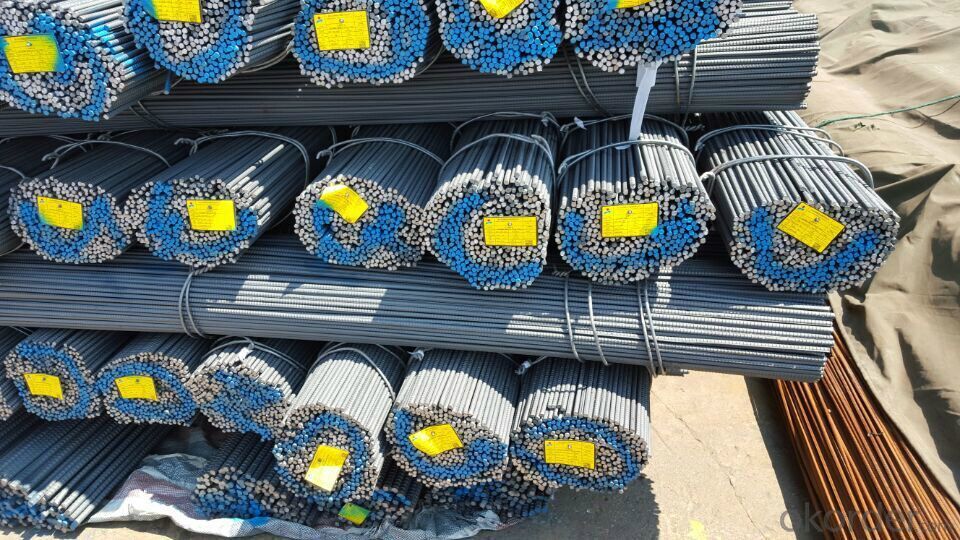
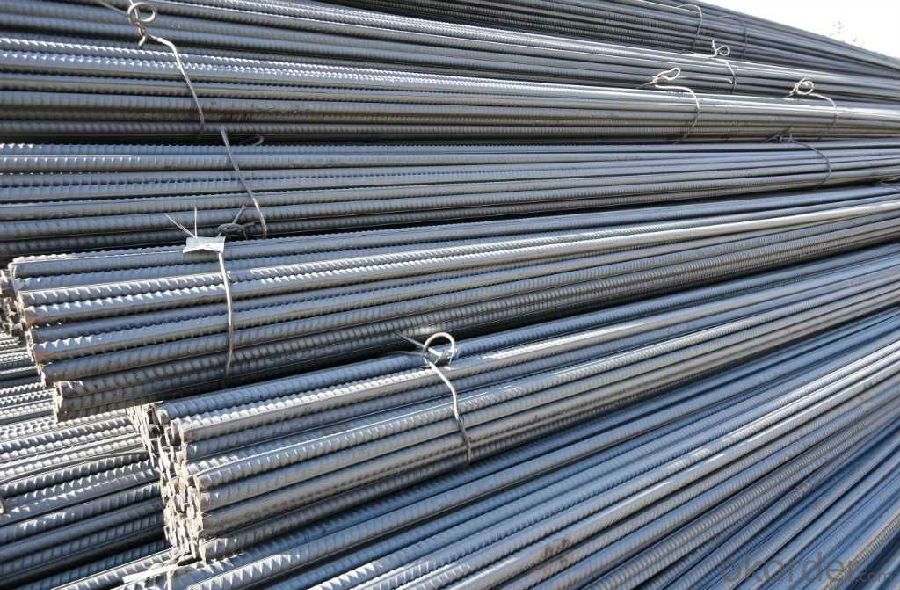
- Q: Can steel rebars be used in earthquake-prone regions?
- Yes, steel rebars can be used in earthquake-prone regions. Steel rebars are commonly used in construction to reinforce concrete structures and improve their strength and durability. In earthquake-prone regions, where buildings need to withstand seismic forces, using steel rebars can help enhance the overall structural integrity and resistance to earthquakes. The flexibility and high tensile strength of steel rebars allow them to absorb and distribute the energy generated during an earthquake, reducing the risk of structural failure and potential collapse.
- Q: What is the process of installing steel rebars in concrete?
- The process of installing steel rebars in concrete involves several steps. First, the concrete surface is prepared by cleaning it from any debris or loose particles. Then, the rebars are cut, shaped, and positioned according to the structural requirements using supports or chairs to maintain proper spacing and elevation. Next, the rebars are securely tied together at the intersections using wire or mechanical connectors. After that, the rebars are placed within the concrete forms, ensuring they are adequately centered and do not touch the sides or bottom. Finally, the concrete is poured, encapsulating the rebars, and left to cure, creating a strong bond between the steel and concrete for enhanced structural integrity.
- Q: What is the impact of steel rebars on the overall carbon footprint of a construction project?
- Steel rebars have a significant impact on the overall carbon footprint of a construction project. The production of steel involves high energy consumption and emits a substantial amount of greenhouse gases. However, steel rebars are essential for reinforcing concrete structures, which have a long lifespan and can contribute to the sustainability and durability of a building. To mitigate their carbon impact, using recycled steel rebars and optimizing their design and placement can help reduce the overall carbon footprint of a construction project.
- Q: How long do steel rebars typically last in construction?
- Steel rebars typically last for the entire lifespan of a construction project, which could range from several decades to even over a century, depending on the specific conditions and maintenance of the structure.
- Q: How do steel rebars contribute to the seismic performance of concrete buildings?
- The seismic performance of concrete buildings is greatly enhanced by steel rebars. These rebars provide reinforcement to the concrete structures, making them more resistant to the powerful forces exerted during an earthquake. Without proper reinforcement, the concrete can crack or collapse under the intense shaking. To strengthen the concrete and mitigate the effects of seismic activity, steel rebars are strategically placed within the concrete, forming a network that increases the tensile strength of the structure. Concrete is strong when compressed but weak when subjected to tension, while steel has excellent tensile strength. By combining the two materials, the rebars effectively distribute the seismic forces throughout the concrete, preventing cracks from spreading and allowing for a more flexible response. Not only do steel rebars improve the tensile strength, but they also enhance the overall stiffness of the structure. This stiffness helps to minimize the building's response to vibrations during an earthquake, reducing the potential for damage. Acting as a backbone, the rebars increase the concrete's resistance to deformation and contribute to the overall structural integrity of the building. Furthermore, steel rebars contribute to the ductility of the structure. Ductility refers to a material's ability to deform under stress without losing its structural integrity. During an earthquake, the building undergoes significant displacement and deformation. Steel rebars allow the concrete to flex and absorb the energy from seismic forces, preventing catastrophic failure. This ductile behavior ensures that the building can withstand the shaking and provides occupants with more time to evacuate safely. In conclusion, steel rebars are essential for improving the seismic performance of concrete buildings. They enhance the tensile strength, stiffness, and ductility of the structure, reducing the risk of damage or collapse during an earthquake. By reinforcing the concrete, steel rebars play a critical role in ensuring the safety and resilience of concrete buildings in areas prone to seismic activity.
- Q: What are the factors that affect the durability of steel rebars in concrete?
- There are several factors that affect the durability of steel rebars in concrete. These include the quality of the steel used, the concrete mix design, the level of exposure to environmental conditions, the presence of moisture and chemicals, and the degree of corrosion protection provided. Other factors such as construction techniques, design considerations, and maintenance practices also play a role in determining the durability of steel rebars in concrete structures.
- Q: What are the guidelines for the proper curing of concrete with steel rebars?
- The guidelines for the proper curing of concrete with steel rebars are as follows: 1. Moisture: Concrete needs to be kept moist during the curing process to ensure proper hydration and strength development. However, when curing concrete with steel rebars, it is important to prevent excessive moisture as it can cause corrosion and damage the steel. Therefore, a balance should be maintained in providing enough moisture without allowing standing water to accumulate around the rebars. 2. Covering: The steel rebars should be adequately covered with concrete during the pouring process to provide protection against corrosion. The cover thickness should be in accordance with the design specifications to ensure sufficient strength and durability. 3. Curing time: The curing time for concrete with steel rebars is typically longer than that of plain concrete. This is because the steel needs to bond with the concrete and achieve proper adhesion. The recommended curing period can vary depending on factors such as ambient temperature, humidity, and the specific type of steel used. It is important to refer to the project specifications or consult with a structural engineer to determine the appropriate curing time for the specific application. 4. Temperature control: During the curing process, temperature control is crucial to ensure uniform hydration and avoid thermal stress. Rapid temperature changes can cause cracking and compromise the integrity of the concrete. It is important to protect the concrete from extreme temperature variations and provide insulation or shading as necessary. 5. Protection from external elements: Concrete with steel rebars needs to be protected from external elements that may cause damage or corrosion. This includes protecting the concrete from exposure to chloride ions, carbonation, and chemicals. Appropriate surface coatings or sealants can be applied to provide an additional layer of protection. 6. Inspection and maintenance: Regular inspection and maintenance are essential to ensure the long-term durability of concrete with steel rebars. It is important to monitor for any signs of corrosion, cracking, or deterioration and take appropriate measures to address them promptly. This may include repairing damaged areas, applying protective coatings, or implementing corrosion prevention measures. Following these guidelines will help ensure the proper curing of concrete with steel rebars, resulting in a structurally sound and durable construction material that can withstand the test of time.
- Q: How do steel rebars help in load distribution within a structure?
- Steel rebars help in load distribution within a structure by providing reinforcement and strength to the concrete. They are embedded within the concrete to enhance its tensile strength and prevent cracking or failure under heavy loads. The rebars act as a framework, distributing the applied load across a larger area and reducing stress concentrations, thereby ensuring the stability and durability of the structure.
- Q: Can steel rebars be used in architectural concrete elements?
- Yes, steel rebars can be used in architectural concrete elements. They provide additional strength and reinforcement to the concrete structure, ensuring its durability and stability. Steel rebars are commonly used in architectural designs such as columns, beams, and slabs to enhance the overall structural integrity of the concrete elements.
- Q: How are steel rebars measured and labeled?
- Steel rebars are measured and labeled based on their diameter, length, and grade. Diameter is typically measured in millimeters, and rebars are labeled with numbers such as #3, #4, #5, etc., which correspond to their diameter size. Length is measured in feet or meters, and rebars are usually available in standard lengths like 20 feet or 6 meters. Finally, rebars are labeled with their grade, which represents their tensile strength, such as Grade 40, Grade 60, etc. These measurements and labels ensure the proper identification and usage of steel rebars in construction projects.
Send your message to us
Reinforcing Deformed Steel Bars with Grade HRB400-HRB500
- Loading Port:
- Tianjin
- Payment Terms:
- TT OR LC
- Min Order Qty:
- 25 m.t.
- Supply Capability:
- 20000 m.t./month
OKorder Service Pledge
OKorder Financial Service
Similar products
Hot products
Hot Searches
Related keywords
